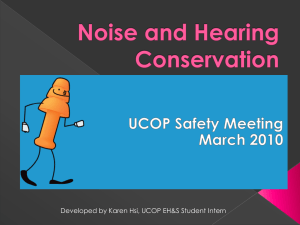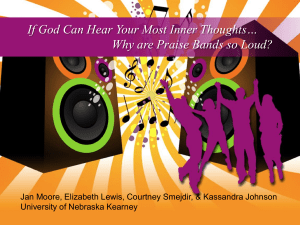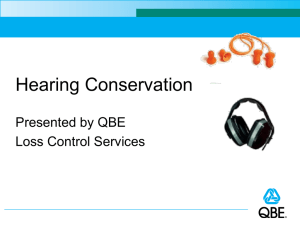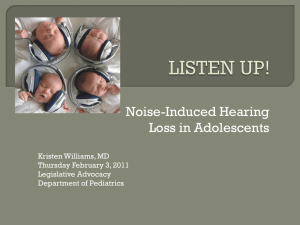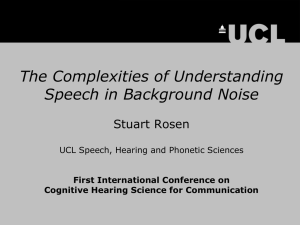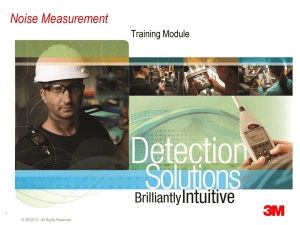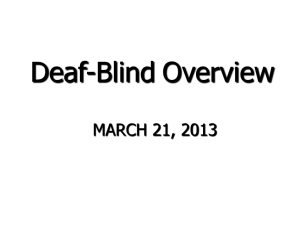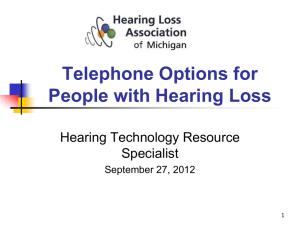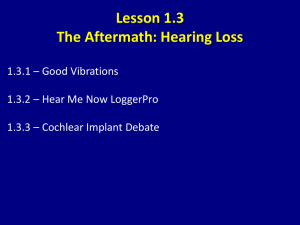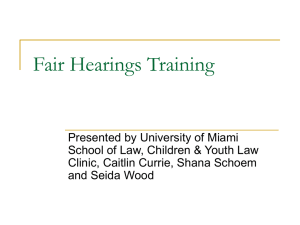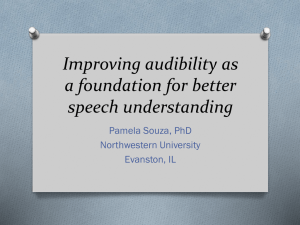Staying On Track With Hearing Conservation
advertisement
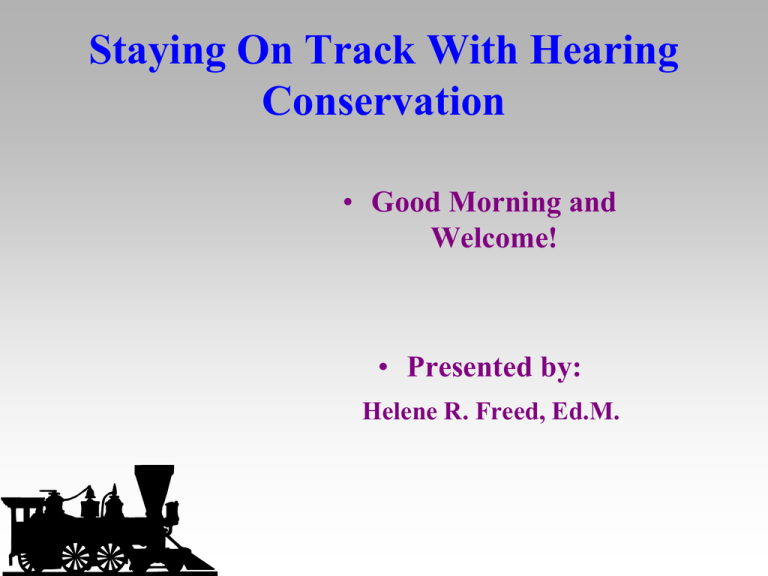
Staying On Track With Hearing Conservation • Good Morning and Welcome! • Presented by: Helene R. Freed, Ed.M. Prevent Hearing Loss: Participate in Hearing Conservation “Blindness separates you from things, deafness separates you from people.” --Helen Keller Hearing Effects quality of life Directly related to our ability to communicate with loved ones Allows us to interact with society and nature. To work and to play safely PREVENTION! IS the most effective approach to the management of hearing loss associated with chronic noise exposure. Some numbers Loss from noise trauma. 30 Million are exposed to injurious levels of noise 10 Million Americans have permanent, irreversible each day. 44% of carpenters and 48% of plumbers have perceived hearing loss. 49% of male, metal/nonmetal miners by age 50 have hearing loss vs. 9% of the general population. 70% of metal and non metal miners will have hearing impairment by age 60. (NIOSH) 90% of coal miners have hearing loss by age 52. NOISE AND ACOUSTICS Hazardous noise exposures occur on the job AND off the job How we hear Acoustic energy to mechanical energy to hydraulic energy to chemical exchange to electrical impulse Ear Anatomy Healthy Hair cells Hair cells after a history of noise exposure Hearing Loss Due To Noise Exposure Is … Painless Permanent Progressive … and very PREVENTABLE! Components Of A Hearing Conservation Program Noise Level Evaluation Audiometric Testing Hearing Protection Record Keeping Training Written Program Noise Level Evaluation HOW LOUD IS IT??? Effects of Noise Exposure When is Noise Too Loud? • Noise is measured in units called “decibels” or “dB” • If two people 3 feet apart must shout to be heard, the background noise is too loud (above 85 decibels). Noise Level Evaluation Personal Sampling by Dosimetry 80 / 90 dBA Criterion Level Engineering / Administrative Controls Formal Documentation Updating Your NLS… When? 5 dB Doubling Effect Remember This When working with the Hearing Conservation Regulation • Legal levels are minimum requirements and do not protect all employees exposed to high levels of noise in the work place. – To protect ALL your employees you need to EXCEED the minimum legal requirements. If results are…. • <85dB No Action Required • >85dB Minimum Legal Requirement • 85dB STS Mandatory HP • 90dB Mandatory for all Exposure at these levels over a work life will produce the following significant hearing losses. • EPA 90dBA 85dBA 80dBA 22% 12% 5% • NIOSH 90dBA 85dBA 80dBA 29% 15% 3% 5 dB Doubling Effect Duration TWA / dBA Dose/PEL 85dB 50% 8 Hrs 90 100% 4 Hrs 95 100% 2 Hrs 100 100% 1 Hr 105 100% 1/2 Hr 110 100% 15 Min 115 100% Remove the hazard Remove the worker Protect the worker Audiometer and Test Environment The test environment must be controlled and testing must be reliable • Testing does not conserve hearing alone • You need to know when how to counsel and educate employees • When to refit and adjust hearing protection • When to recommend engineering and administration controls Engage All Stakeholders “Engage persons having an investment in what will be learned ...and what will be done with the knowledge” What is M-O-T-I-V-A-T-I-O-N? • An inducement • An emotion, desire, physiological need, or similar impulse that acts as an incitement to action • To stir to action or feeling • To egg on, excite, goad, inspire, instigate, move, pique, prick, prod, prompt, propel, provoke, set off, spur, trigger • ENCOURAGE • CHEER ON Purpose of Test • Identify temporary hearing losses before they become permanent • To take remedial steps Normal Hearing 250Hz 500Hz 1kHz 2kHz 3kHz 4kHz 6kHz 8Hz Rising Audiogram Unilateral Sloping Audiogram Protecting your hearing also protects you against: Tinnitus: Ringing or buzzing 25% have difficulty coping with tinnitus It’s associated with disruption of sleep, stress and depression. 1 In 200 can’t lead a normal life. Hyperacusis/Recruitment: Abnormal reaction to loudness changes which often accompanies SNHL Phonophobia:Fear of noise that can accompany hyperacusis accompany Occupational Noise isn’t our only concern. Recreational Sports create Dangerous Decibels VUVUZELAS 113 dBA at 2 meters! Once in a HCP, how long does an employee have to go without being exposed at 85dB to be removed from the program? Employees who have not been exposed to noise = or >85dB for an entire year following their last annual audiogram may be removed from program. STS Follow-Up Employee may obtain a Retest within 30 days: a. If shift is found to be temporary, no further follow-up is necessary. b. If shift is found to be PERSISTENT, or a retest is NOT performed you must: a. Notify In Writing b. Retrain on proper fitting of hearing protection c. Mandatory hearing protection >85 dBA SUMMARIZE RESULTS • • • • Look for trends in certain areas, depts. STS should not exceed >10%population Upon retest, show more TTS Make HPD use and compliance part of the contract of employment – In writing – With disciplinary action Don’t make the mistake of thinking your job is done if you simply provide hearing protection and periodic hearing tests. Train workers how to recognize noise hazards, utilize noise controls, and use of hearing protection. Hearing Protection No Cost to the Employee Offer at least 2 types / Custom Plugs 85dBA offered vs. 90 dBA mandatory Attenuation / NRR Types of Hearing Protectors Earplugs – Single-Use – Multiple-Use – Detectable Banded Protectors – Banded Earplugs – Canal Caps Earmuffs – Standard (Headband) – Cap-Mounted – Electronic – Special Application Make Hearing Protection Mandatory at 85dBA New Hires STS Save More Hearing. Halve Their Exposure Reduces Risk of Hearing loss From 25% to 8% Make this a policy of employment! NOISE LEVEL EVALUATION AUDIOMETRIC TESTING TRAINING HEARING PROTECTION RECORD KEEPING ***WRITTEN PROGRAM*** AUDIOMETRIC TESTING 1. All employees assigned to AREA A will receive baseline audiogram within six months of first high noise exposure and mandatory hearing protection. 2. Audiograms will be given annually and compared to baseline to determine if a STS has occurred. 3. Mandatory Hearing Protection is required in the following areas: TYPES OF HEARING PROTECTION • EAR PLUGS / NRR • EAR MUFFS / NRR
